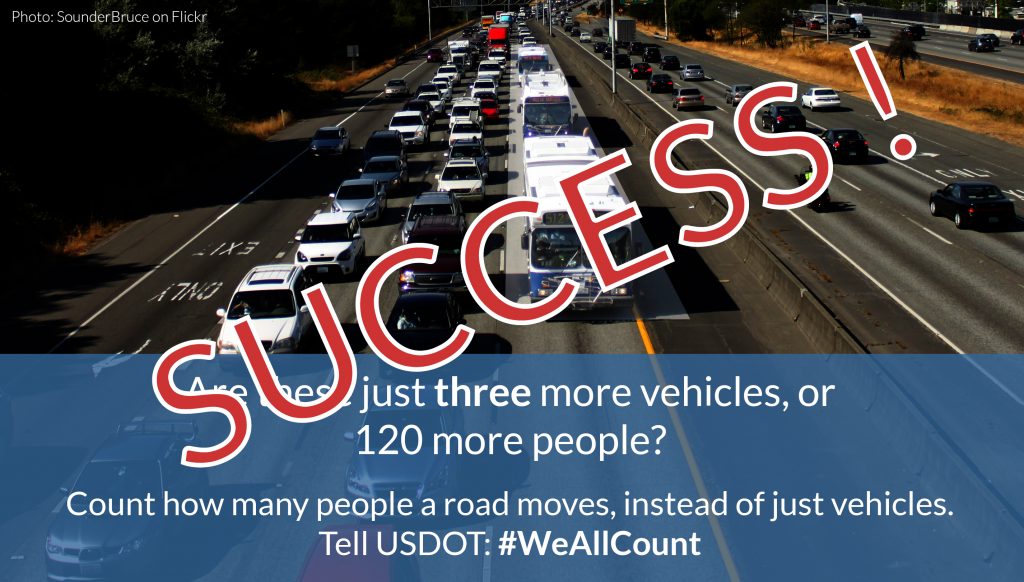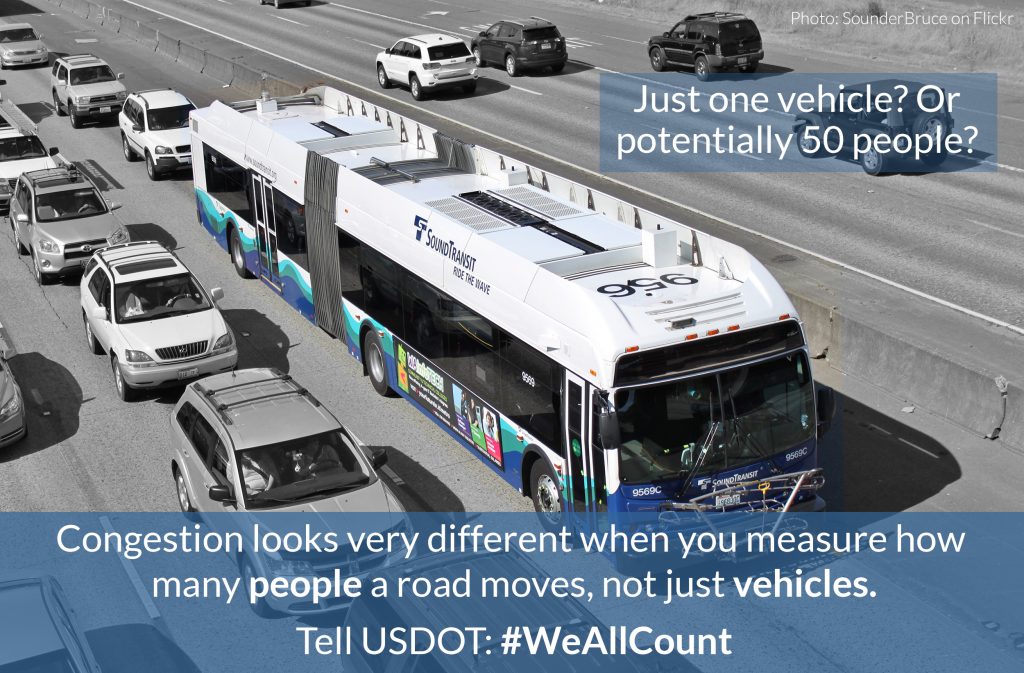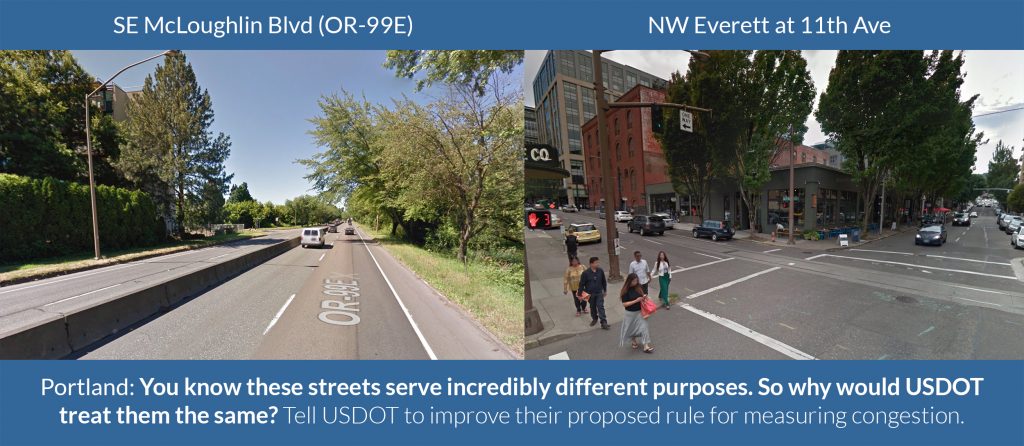
USDOT rewrites congestion rule in response to outpouring of feedback

At long last, USDOT has finalized new requirements for how states and metro areas will have to measure traffic congestion and in the final rule — responding to the outpouring of comments they received — they backed away from most of the outdated measures of congestion that were proposed.

Updated 1/26/17: See the bottom of this post for a video of our webinar explaining this rule and the rest of the final package of performance measures. – Ed.
Wait, what congestion measures? First, let’s take a moment to catch up on what’s happening here, since it’s been months since this was in the news.
For two years, USDOT has been working to establish a new system of performance measures to govern how federal dollars are spent and hold states and metro areas accountable for making progress on important goals, including how states and cities would have to measure (and address) traffic congestion. (Why does how we measure congestion matter? Read some background here.)
As first written, USDOT’s proposed measures would, as we said back in early 2016, “induce sprawl, harm the economic potential of our main streets by treating them like highways, punish cities investing in public transportation, completely ignore people walking, biking, carpooling or telecommuting, and push local communities of all sizes to waste billions of dollars in vain attempts to build their way out of congestion.”
So back in August 2016, we delivered letters from nearly 5,000 individuals and 150 organizations — including dozens of local chambers of commerce and elected officials — opposing USDOT’s flawed proposal and urging them to rethink their approach.

Here’s what 5,000 letters looks like next to a terrific book about Complete Streets for scale purposes since USDOT allows digital submissions.
We’ll be reviewing this newly-released 300-plus page measure in closer detail in the days to come, but our first take upon reviewing it is that FHWA heard the extensive feedback on a complex rule and responded positively to most of the requests that we made.
“Tens of thousands of commenters, through campaigns from T4America, the American Heart Association, and others, raised concerns about the vehicle-focused nature of the eight measures proposed in the NPRM,” FHWA wrote in their comments accompanying the new rule.
The changes are complicated and difficult to quickly enumerate, but four changes are worth highlighting quickly here.
First, we complained that FHWA’s singular focus on delay “paints an incredibly one-dimensional picture of congestion. Focusing on average delay by simply measuring the difference between rush hour speeds compared to free-flow 3 a.m. traffic fails to count everyone else commuting by other modes, rewards places with fast travel speeds at the expense of places with shorter commutes and less time spent behind the wheel overall, and completely ignores how many people are actually moving through the corridor.”
In response, FHWA dumped this peak travel reliability measure, more commonly expressed through the Texas Transportation Institute’s travel time index (TTI), which mostly is a measure of the difference between speeds in the middle of the night and rush hour. This peak travel time measure is gone.
Secondly, they added a “person-hours” measure of delay, which will consider how many people are using the road instead of just how many vehicles are delayed. This was one of our primary critiques of the draft rule, because simple vehicle delay is blind to how many people a corridor is actually moving — it only looks at the number of vehicles. If one corridor moves three times the amount of people as another corridor because of a carpool requirement or a lane dedicated to high-capacity transit, it shouldn’t score the same for congestion just because the travel speed or average delay is the same.
This is a significant change. This means that a congested road that’s full of single-occupant vehicles will never be viewed the same as a corridor that is congested but also multimodal or otherwise carrying more people.

Thirdly, and responding clearly to feedback, FHWA added a new carbon dioxide emissions measure to track the percent change in CO2 emissions generated by on-road mobile sources on most bigger roadways. (Specifically roads on the National Highway System, which, as this graphic reminds us, aren’t always just highways.)

Fourth and lastly, on the topic of multimodal corridors, “…after reviewing these comments, FHWA has decided to include a new multimodal measure — the portion of non-single occupant vehicle travel.”
How did FHWA explain their reasoning to add a measure requiring states and metro areas to set a target for moving people via modes other than single-occupant vehicles?
“Because transportation in urbanized areas is inherently multimodal, it is important to account as much as possible for the options that are available to travelers in those urbanized areas.”
How we measure congestion does matter. It is important to look at congestion and its connection to economic activity. This post from a department within FHWA on Twitter today highlights this connection and it isn’t what most elected leaders and transportation officials believe. Congestion is bad for economic success, right?
Wow Wednesday! The top 5 fastest—and slowest—commutes by State in 2015. More info: https://t.co/DuwWRhP04L pic.twitter.com/ZMzShITkuH
— Federal Highway Admn (@USDOTFHWA) January 11, 2017
Especially after the collapse of the recent Bakken-fueled oil boom of the last few years there, do you think that North Dakota’s leaders would trade ten minutes on their average commute times for ten percent of New York State’s GDP? Does the lack of congestion equal economic success?
This final performance measure from FHWA and USDOT would suggest otherwise. They are to be applauded, and it wouldn’t have happened without your support. By FHWA’s own admission, the letters that you and thousands of others sent were responsible for pushing FHWA on these critical points.
Stay tuned for more, and sign up for email from T4America to get this kind of news straight to your inbox, including news about a detailed webinar about the new rules happening soon.
Updated: Here’s the video of our webinar about the new performance measures. Read this post for more information.



